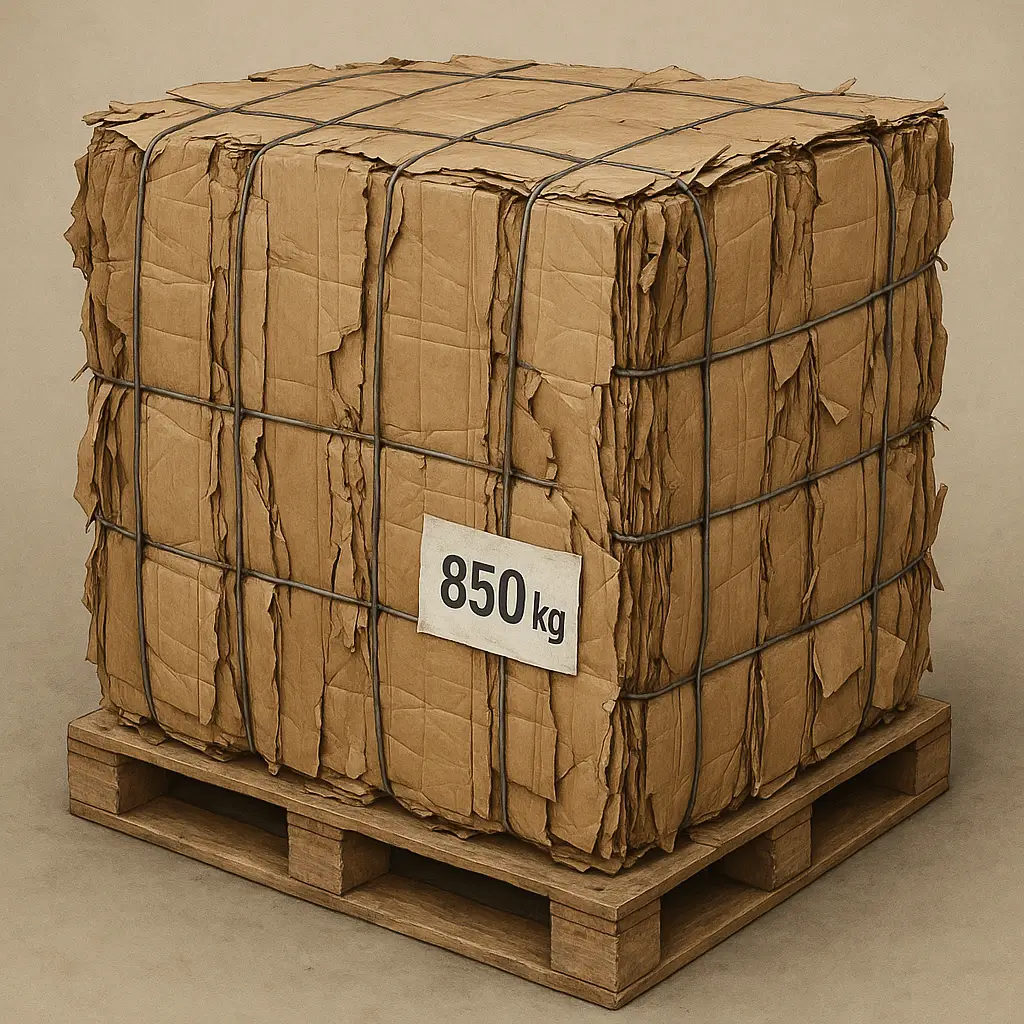Key Takeaway: A cardboard bale can weigh anywhere from 100 lbs for small-office bales up to 1,500 lbs or more for heavy-duty mill-size bales. Typical medium-size bales produced by vertical balers average around 660 lbs (300 kg), while industrial mill-size bales often range between 800 lbs and 1,100 lbs. Variations in weight stem from bale dimensions, compression force, moisture content, and cardboard type.
1. What Is a Cardboard Bale?
A cardboard bale is a compacted block of flattened cardboard boxes and paper packaging, held together by wire or plastic strapping after being processed through a baling machine. Baling serves to:
- Reduce volume by up to 90%, minimizing storage and transportation costs.
- Streamline recycling, separating cardboard from other waste streams.
- Generate revenue, as recyclers pay by bale weight.
Baler types include vertical balers (common in businesses) and horizontal balers (used by high-volume processors). Bale dimensions and weight depend on the baler model and operational settings.
2. Standard Bale Weights and Dimensions
There is no single “standard” bale weight, as equipment designs and operational practices vary. However, balers are often categorized into small, medium, and large based on the bales they produce:
| Bale Category | Typical Dimensions (W×H×D) | Weight Range | Density Notes |
|---|---|---|---|
| Small | 23″ × 28″ × 7.5 ft³ (approx. 600×700×200 mm) | 100 – 280 lbs (45–130 kg) | Produced by light-duty vertical balers for small volumes. |
| Medium | 31.5″ × 47.2″ × 31.5″ (80×120×80 cm) | 660 lbs (300 kg) | Average medium mill-size bale; common in many facilities . |
| Large | 30″ × 48″ × 60″ (76×122×152 cm) | 800–1,000 lbs (360–454 kg) | Heavy-duty vertical balers, known as mill-size bales . |
| Industrial | 40″ × 48″ × 72″ (102×122×183 cm) | 1,000–1,500 lbs (454–680 kg) | Horizontal balers and 72″ vertical high-density models . |
All weights and dimensions are approximate; actual results vary by cardboard thickness, compaction pressure, and moisture.
3. Factors Influencing Bale Weight
3.1 Baler Type and Compression Force
- Vertical Balers: Produce bales by pressing downward from the top platen. Light-duty models yield lighter bales (100–300 kg), whereas heavy-duty vertical balers create bales up to 1,100 lbs.
- Horizontal Balers: Offer greater platen force (often exceeding 50 tons) and larger bale volumes, producing industrial mill-size bales of 1,000 – 1,500 lbs.
3.2 Bale Dimensions and Volume
- A bale’s volume (in cubic feet or cubic meters) directly impacts its mass at a given density.
- Larger bale sizes (e.g., 72″ width) yield greater mass even at similar compression densities.
3.3 Cardboard Type and Pre-Bale Density
- Corrugated cardboard (OCC): Higher density due to fluted layers, yielding heavier bales.
- Paperboard or mixed paper: Lower density, resulting in lighter bales for equivalent volume.
3.4 Moisture Content
- Wet cardboard retains additional water weight but is often rejected by recyclers due to fiber degradation and mold risk.
- Recyclers require dry bales; moisture can lead to payment penalties or bale rejection.
3.5 Strapping Method and Tolerance
- Wire ties allow tighter compaction and higher bale densities.
- Plastic strapping yields slightly less dense bales, reducing overall weight by up to 5–10%.
4. Optimal vs. Maximum Bale Weight
Balers and recyclers advocate for “optimal” bale weights—heavy enough to maximize trailer payloads without exceeding weight limits or creating handling hazards. Example:
- A standard 88 m³ trailer can carry up to 24,000 kg (52,910 lb).
- Using 500 kg bales allows 48 bales (24,000 kg total), avoiding overloading and excessive stacking height, improving safety and efficiency.
5. Industry Terminology: Mill-Size Bales
Mill-size bales refer to bales that meet recycler specifications for direct mill processing:
- Dimensions: 1.2 m × 0.8 m × 1.1 m (120 × 80 × 110 cm)
- Weight: 400–600 kg (880–1,320 lbs)
- Tie: Must be wire-tied (not taped), ensuring durability during transport.
These specifications optimize transport, handling, and revenue, as mills prefer uniform, heavy bales.
6. Converting to Pounds
For businesses and recyclers using imperial units, common conversions:
- 1 kg = 2.20462 lbs
- A 300 kg bale = 660 lbs
- A 500 kg bale = 1,102 lbs
- A 600 kg bale = 1,323 lbs
7. Typical Weight Ranges by Baler Category
| Baler Category | Weight Range (lbs) | Weight Range (kg) | Notes |
|---|---|---|---|
| Light-duty vertical | 100 – 280 | 45 – 130 | Small offices or retail outlets producing low volumes . |
| Medium vertical | 444 – 768 | 200 – 350 | Common for medium production; space-efficient. |
| Standard mill-size | 660 lbs | 300 kg | Benchmark for many recyclers; “standard” bale weight . |
| Heavy-duty vertical | 800 – 1,000 | 360 – 454 | Often called mill-size bales; high compaction. |
| Horizontal/72″ HD | 1,000 – 1,500 | 454 – 680 | For large-scale recycling operations . |
8. Practical Implications for Businesses
8.1 Cost Savings
- Reduced disposal fees: Baled cardboard reduces volume in dumpsters.
- Revenue generation: Recyclers pay per tonne; heavier bales increase rebate.
8.2 Logistics and Handling
- Optimal bale weight avoids overloading trucks and minimizes manual handling injuries.
- Proper storage under cover preserves bale integrity and value.
8.3 Equipment Selection
- Assess monthly cardboard volume (in tonnes) to choose between small, medium, or mill-size balers.
- Consider footprint, staffing, and storage capacity when selecting baler type and bale size.
9. Conclusion
The weight of a cardboard bale spans a wide spectrum—from as little as 100 lbs for small-office bales to over 1,500 lbs for mill-size, high-density bales. The average medium bale produced by vertical balers is around 660 lbs (300 kg) , while industry mill-size bales typically weigh between 800 lbs and 1,100 lbs. Variations arise from baler type, bale dimensions, compression force, moisture content, and cardboard type. Understanding these factors enables businesses to optimize bale weight for maximum cost savings, revenue generation, and operational efficiency.



Leave a Reply